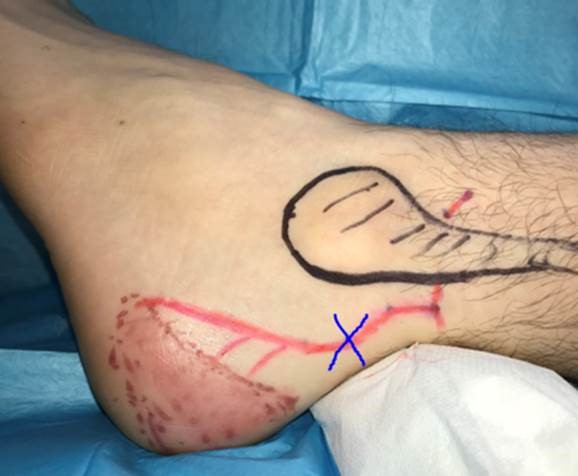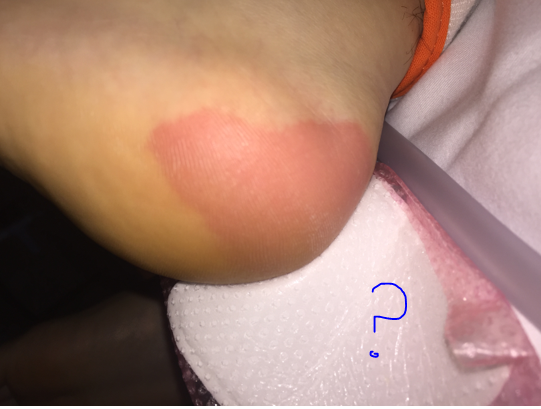In 2019 when Dr. Gksoulias and I published “On the Origin of Intraoperative Pressure Injury: An Angiosomal Theory of Pressure Injury Formation,” I didn’t make a big deal about the photo above, but I think it’s time to talk about it.
To look at this heel pressure injury, I had to peel back the foam pad that had been placed there as a preventive measure. It’s time we asked ourselves whether a thin foam pad could prevent an ischemia reperfusion (IR) injury caused by the obstruction of a named blood vessel several centimeters proximal to the area.
Do we really think that the pad in the photo could prevent an ischemic injury that originates several centimeters away? They may work to prevent friction and sheer over the local area, but not IR injuries proximally. That’s why they fail.

My hospital spends half a million dollars a year on these pads for prevention. My hospital system spends $5 million a year on them as part of a “get to zero” campaign. I hate this slogan. It implies that using interventions like this, we COULD “get to zero” pressure injuries. We clearly aren’t stopping them all, and the reason may be that our interventions are not directed at the right pathophysiological process. I suspect that if we gave $5 million to a researcher in the field, they could come up with a mitigation strategy that did work.
For more information about this heel [ischemia reperfusion] injury, see my previous article Yes! It IS a Pressure Injury! An Ischemia Reperfusion Injury…
Caroline

Dr. Fife is a world renowned wound care physician dedicated to improving patient outcomes through quality driven care. Please visit my blog at CarolineFifeMD.com and my Youtube channel at https://www.youtube.com/c/carolinefifemd/videos
The opinions, comments, and content expressed or implied in my statements are solely my own and do not necessarily reflect the position or views of Intellicure or any of the boards on which I serve.




Hello, I would like to congratulate Dr Fife for these excellent contributions.
Like her, I am terrified by expressions such as “zero” or that “95% of pressure injuries are avoidable” – frankly, these are statements that can be thrown at us.
As for pressure injury preventive measures, these must be appropriate to a logical context that takes into account the patient’s circumstances, and at no time do they exclude one another. Local pressure relief with pressure management dressings can in many cases be an effective measure, and we have evidence of this, always in a global context of preventive care (local skin care with hyperoxygenated fatty acids, repositioning at appropriate intervals, use of pressure management surfaces appropriate to the risk and clinical situation of the patient, etc.).
The case in question raises the inexcusable need to address the problem of pressure injuries from the point of view of Patient Safety, and within this, from the notification of any new injury, whatever its category, to look back and see what has gone wrong, and if necessary, to evaluate the preventive measures, to look at the factors that have caused the injury, to see what has gone wrong, and if necessary, to evaluate the preventive measures, to look at the factors that have caused the injury, to look at the factors that have caused the injury, evaluate preventive measures, look at factors that may detract from their effectiveness or discover circumstances that we were not aware of before, such as vascular compression caused by devices that seek patient comfort, or more seriously, the prevention of “pressure injuries” leading to very severe injuries.
Only by recognising our mistakes and looking back, we can generate knowledge to improve our preventive practice and make the most effective use of the resources we have. In this way we will be able to reduce the incidence of pressure injuries.
We are faced with a clear and brilliant example of this, which has allowed the development of the angiosomal theory in the development of deep tissue pressure injuries that have not responded to the usual preventive measures.
I insist once again, congratulations Dr Fife for her Blog and for their more than brilliant contributions that will undoubtedly help to improve the prevention of pressure injuries.¡
Kind regards from Barcelona! Dr Joan Enric Torra Bou, (GNEAUPP, EPUAP, Universitat de Lleida), editor of the blog PIEL SEGURA (Safe skin in Spanish) , on patient safety and advanced practice nursing in wound care. http://www.sapiensjetorrabou.com